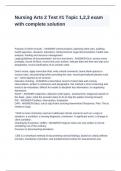Nursing Arts 2 Test #1 Topic 1,2,3 exam
with complete solution
Purpose of client records: - ANSWER-communication, planning client care, auditing
health agencies, research, education, reimbursement, legal documentation, health care
analysis, funding and resource management
Legal guidelines of documentation: list do's and dont's - ANSWER-Do's: correct errors
promptly, record all facts, record only your actions, indicate date and time and sign your
designation, record clarification of an unclear order.
Dont's erase, apply correction fluid. write critical comments, leave blank spaces in
nurses notes. documenting before providing the care. record generalized phrases such
as: " client appears to be anxious"
Narrative charting - ANSWER-a descriptive record of client data and nursing
interventions, written in sentences and paragraphs. this method is time consuming and
tends to be redundant. difficult for reader to decipher key information. no organizing
framework.
SOAP - ANSWER-subjective, objective (vital signs) , assessment ( Diagnosis based on
the data) , plan ( what the provider plans to do to help the patient moving forward)
PIE - ANSWER-Problem, Intervention, Evaluation
DAR - ANSWER-Data ( sub & obj) Action (nursing intervention) Response, Plan. This is
similar to soap.
* DAR is most commonly used as it addresses clients concerns such as: a sign or
symptom, a condition, a nursing diagnosis, a behavior. A significant event, a change in
client condition.
Charting By Exception: (CBE) - ANSWER-Progress notes are only written to record
something out of the ordinary.
Focuses on documenting deviations
CBE is a shorthand method of documenting normal findings, based on clearly defined
normal's, standards of practice, and predetermined criteria for assessments and
, interventions. Significant findings or exceptions to the predefined norms are
documented in detail.
What is a problem oriented medical record? - ANSWER-Medical record organized by a
pts specific health problems and include a:
1. database
2. problem list
3. plan of action for each problem
4. Progress notes (in SOAP format) PIE, SOAPIE, DAR
Incident Reports - ANSWER-Event that is not consistent with the normal routine, ie:
client falls, needle stick injuries, medication errors. These are examples of when you
would file an incident report.
You always document every single incident report and as soon as it happens. You
would never not file an incident report if it happens.
If you are involved in an incident you must: notify the charge nurse/ your instructor.
Secure the area. initiate immediate intervention as well as file an online incident report.
Admission History: form of charting - ANSWER-This documentation is used for patients
upon admission. It guides the nurse through a complete overall assessment of the
client. Provides a baseline for comparison, ie: vital signs. Provides data which is then
used to determine a nursing diagnosis.
Flow sheets and graphic records, intake and output - ANSWER-This means to quickly
and easily enter assessment data. This may include other repetitive care actions such
as: V.S, hygiene, ambulation, restraint checks, weight.
• Graphic record
• 24-hour fluid balance
• Medication record (MAR)
• 24-hour patient care records
• Allows for quick review and tracking of patient status in a variety of indicators (fluid
balance, temperature......)
Kardex, Integrated/ Individual Care Planning - ANSWER-provides detailed information
on each clients orders, treatment, diagnostic testing, assistance required with ADL's,
ACP level, Safety requirements, teaching, etc.
Continually updating as client condition changes and new orders are received.
Provides a quick reference for the nurse.
Common elements: basic demographic data, hospital identification number, medical
and surgical history, nursing care plan, advance care plan level, allergies.
Discharge Summary Forms - ANSWER-Discharge begins at admission, requires
involvement of client and family in the discharge planning process. Discharge
documentation includes medications, diet, community resources, follow up care, and
whom to contact in case of an emergency or for questions.





